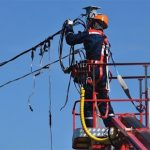Precision GPS for New Opportunities
It is now much more economical to consider applications that require higher accuracy than previous generations of receivers. The ability to receive the L5 GPS signal adds to the ability to receive any signal at all in impaired environments. The L5 signal is 13dB stronger than the L1 signal. No, GNSS still wont work deep in a parking garage or inside ventilation ducts like the movies love to show but it will likely work deeper into that garage or urban canyon than single frequency L1 receivers. If your receiver can hear both signals, you’ll see better coverage.
Dual band GNSS receivers also have the ability to be more accurate by removing ionospheric propagation errors created by atmospheric conditions. How much more accurate the system can be depends on the details of the receiver but in general a dual band receiver can be more accurate than a single band receiver.
So who cares about this added level of performance? Any application where coverage is impaired by trees, buildings, or any other structures. Less obvious applications would include animal monitoring (inside fence or outside), training (invisible fence), vehicle storage and retrieval, interactive remote guidance (yes go in that door) and invariably dozens of others that haven’t been considered yet. That’s the point, this new level accuracy and coverage changes the status quo of the technical and economic business case when using GNSS.
At F3 Wireless we’re building cutting edge custom IoT hardware and software focused on mass deployments to explore exactly these kinds of new market opportunities. If you have a business case, our experts can help you explore and understand the technical and economic implications of this new development.




